#modernist contributions
Text

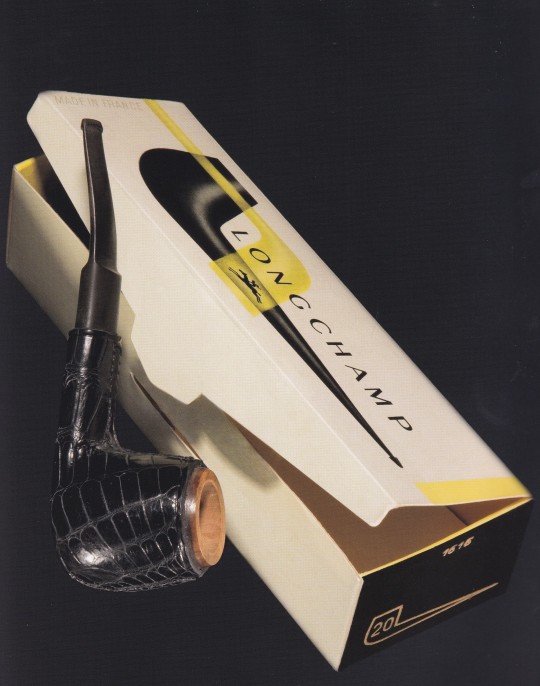

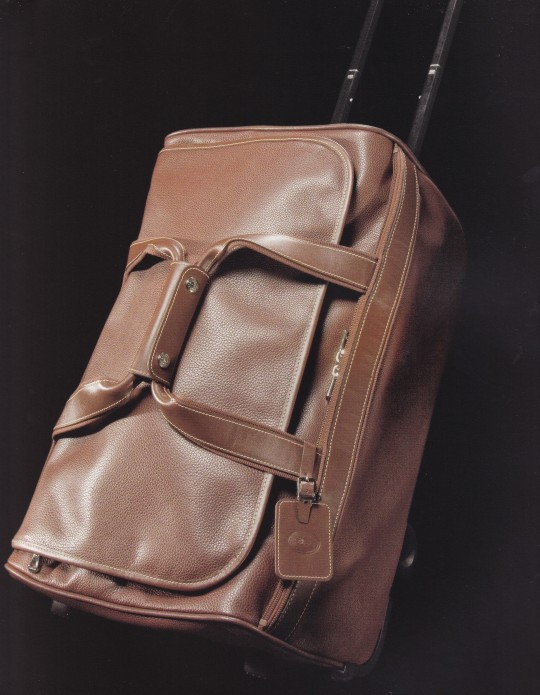
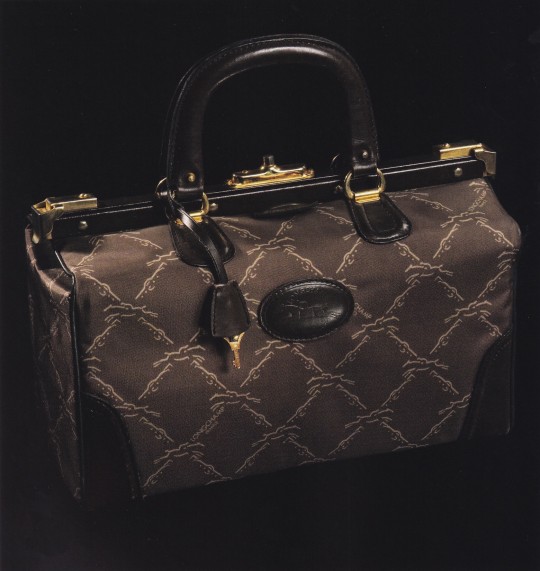



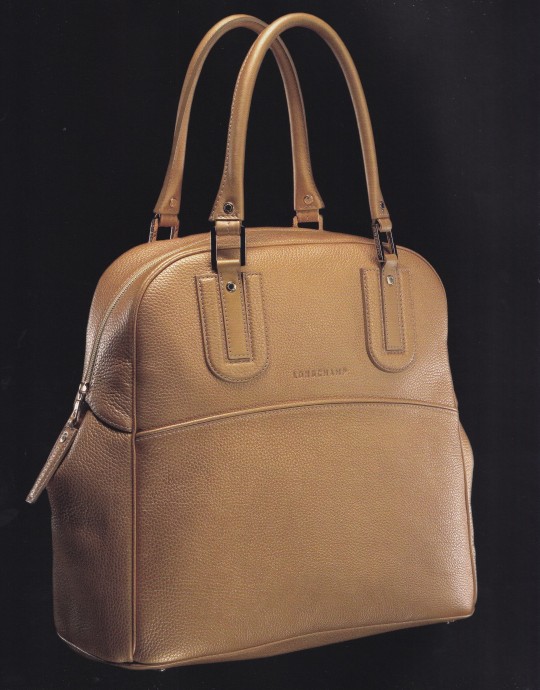

Longchamp
Marie Aucouturier
Phot. Philippe Garcia
Éditions de La Martinière, Paris 2008, 190 pages, 25x28,5cm, ISBN 978-0-8109-2107-8
euro 60,00
To celebrate 60 years of chic handbag classics, French accessories label Longchamp present a book documenting the success behind the family brand published by Éditions de La Martinière. From creative process to production, style photographer Phillippe Garcia transports the reader on a visual journey by presenting photography from unpublished archives, alongside modernist contributions from global artists.
02/03/24
#Longchamp#60 years#Philippe Garcia#unpublished archives#modernist contributions#global artists#fashion books#fashionbooksmilano
4 notes
·
View notes
Text
I wish americans would have more pride in their states than how they do for the whole country.,..i just think it would be interesting and worth it. LIKE the USA is so LARGE and there are all kinds of ways of living here and so many types of people here so why does everyone wanna make everywhere look exactly the same!!!!!! I wish states had some more opportunities to develop a more distinct culture... the californians and texans are already really good at having lots of pride in their state and PERSONALLY i think EVERY state in america has something to be proud of yes even the one you think is boring as hell!! every state is special in its own way :3 there is something to appreciate for everywhere on earth
#bloggy#like i just want to see like#a Kansas Cuisine restaurant or something#I want to see the modernist iowan architecture...#the oklahoman goth music....#why are people so focused on making everywhere in the country look the same act the same etc#this opinion of mine contributed greatly to my creation of st. lawrence centre btww :]
12 notes
·
View notes
Text

Yiddish writers, Warsaw, 1922
From left to right, with short biographies:
Esther (Esye) Elkin (?–?) was the wife of Mendl Elkin.
Mendl Elkin (1874–1962) was born to a family of Jewish farmers in Belarus. Though working as a dentist for six years, he was more interested in arts and culture, and would spend his spare time writing for socialist newspapers and acting in an amateur Russian-Yiddish theatre group. He spent the 1910s–1920s between Bobruisk and Siberia before moving to Vilna and founding a theatre group, as well as editing literary journals and writing poetry. He would later move to New York, where he served as Chief Librarian for YIVO.
Peretz Hirschbein (1880–1948) was born near Grodno; his father operated a water mill. He studied at a yeshiva before becoming a Hebrew teacher. In his 20s he began to write poetry and plays in both Hebrew and Yiddish, and would soon move to Odessa to stage his plays. After his theatre troupe disbanded in 1910, he spent the remainder of his life travelling, finally moving with his wife Esther Shumiatcher to Los Angeles.
Uri Zvi Grinberg (1896–1981) was a Yiddish writer before moving into Hebrew. Born into a Hasidic family in what is today Ukraine, he served in the Austro-Hungarian army. Radicalized by the November 1918 pogrom in Lwów, he spent the interwar period between Palestine and Europe. He co-founded the self-proclaimed fascist group Brit HaBirionim and later served as a Member of Knesset for Herut. He was awarded the Bialik Prize three times, as well as the Israel Prize for his contributions to literature.
Khane Kacyzne (?–?) was the wife of Alter Kacyzne. Together they had a daughter, Shulamith, who survived the Holocaust by hiding as a non-Jew. Khane was murdered at Bełżec.
Alter Kacyzne (1885–1941) was a prolific photographer and writer, born to a bricklayer and a seamstress in Vilna. He took up photography early, at age 14, by which point he had also taught himself Hebrew, Polish, German, Russian, and French (alongside his native Yiddish) and had begun to write poetry. Through the interwar period he worked as a photojournalist, travelling extensively, as well as serving as editor for several literary magazines and writing for communist newspapers. He was beaten to death by Ukrainian fascists in 1941, and his wife Khane was murdered at Bełżec extermination camp.
Esther Shumiatcher (1896–1985) was born in Grodno, though her family emigrated to Alberta, Canada in 1911. Interested in poetry and screenwriting, she worked several jobs to make money: as a waitress, in a meat-packing plant, and helping her family run a boarding house out of their home. In the 1920s she went to Warsaw and worked extensively as a poet; her poem "Albatros" gave its name to a modernist Yiddish journal. She was married to Peretz Hirschbein, whom she met while he was taken ill in Calgary and nursed back to health in her family's home. After her husband's death in 1948, she moved to New York.
From the YIVO Archives.
#yiddish#yidishkeyt#jewish#jewish history#uri zvi greenberg#uri zvi grinberg#esther shumiatcher#peretz hirschbein#perets hirshbeyn#alter kacyzne#khane kacyzne#mendl elkin#esther elkin#1922#jumblr
66 notes
·
View notes
Text

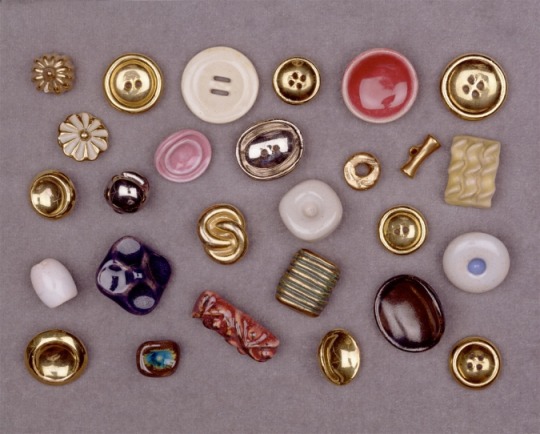





Ceramic buttons by Lucie Rie
Celebrated as one of the most important studio potters of the 20th century, Dame Lucie Rie is famous for her distinctive modernist tableware and vessels. However, it is through Rie’s lesser-known, early work making buttons in the 1940s that we discover the fascinating story of her arrival in London as an Austrian Jewish émigré, the establishment of her career, and how she came to develop her innovative array of glaze textures and colours. These small, wearable objects reveal a story of survival and collaboration at a poignant moment of international conflict.
Born in Vienna, Rie studied pottery at the Vienna Kunstgewerbeschule under decorative artist and sculptor Michael Powolny. In 1925 Rie set up her first studio in Vienna, and, over the next twelve years, established her place in the artistic community, winning a silver medal at the Paris International Exhibition of 1937. In 1938 she, like other artists such as Frank Auerbach, Naum Gabo and fellow ceramicist Hans Coper, fled Nazi-occupied Austria to begin a new life in London.
Upon arrival in London, Rie continued to work and volunteered for Home Defence duties. However, whilst establishing her studio in London and a new market for her work, Rie needed to make a living. Fellow Venician, Fritz Lampl, was re-establishing his glass manufacturers in London, successfully producing a range of modern decorative glass tableware and figurines for the luxury market. Lampl also began producing press-moulded and blown glass buttons and offered Rie and others work at his company, Bimini, to supplying glass buttons to fashion houses and department stores such as Harrods and Liberty’s.
Rie began to produce her own stoneware buttons in her studio at her house near Hyde Park. She made buttons on the wheel and by hand, producing up to two hundred buttons a week. In 1942 Rie hired Rudolf Neufeld, a fellow refugee, as an assistant. Together they developed a series of plaster moulds, which rapidly sped up the production of the simpler button shapes. The moulds remained on the shelves in her studio until her death. Rie developed a wide range of button designs and employed six people, including Hans Coper, in her studio to support production. Rie also developed a range of innovative glazes that contributed to the development of her distinctive later glaze textures and colours, that she’s so well known by.
The more elaborate and expensive buttons were aimed at the couture market and were laid out on presentation panels so that visitors to the studio could pick out designs. Leading fashion designers of the period also sent fabric samples to the studio, and within a few days she would have to produce buttons to match. In 1980 Rie met the Japanese fashion designer Issey Miyake, and their friendship resulted in the 1989 exhibition ‘Issey Miyake meets Lucie Rie’ at Tokyo’s Sogetsu Gallery. In the same year, Miyake also used several of her wartime buttons in his collection.
Rie later extended the range to include a variety of jewellery, umbrella handles, and frames for mirrors. For her, the business represented a pragmatic approach to generating an income during the war. However, today the buttons represent a fascinating insight into this lesser-known aspect of Rie’s highly documented career.
Katharine Malcolm, April 2023
https://www.vam.ac.uk/.../lucie-rie-a-secret-life-of-buttons
https://www.apollo-magazine.com/lucie-rie-ceramics.../
52 notes
·
View notes
Text
I was reading some articles about the relatively recent creation of heritage listing for 20th century Chinese architecture, written by Chinese and white authors, and they just read as so colonial and cringe I actually wanted to cry. To prevent me from bursting into tears I produced a small rant.
One of the articles argued that architecture of the early PRC was inherently political because of the communist regime, but I immediately sensed something was off as the author did not pass a single comment about how most if not all architectural discourse and design during the Republican era was informed by Western colonialism, from the adoption of Western historicism and classicism, later a general desire to appear modern (whatever “modern” meant) to physical buildings being built by white architects or commissioned by white patrons for colonial purposes (e.g. missionary work). The authors acknowledged that those styles were “Western” and “foreign”, but no mention of the colonial is made. It’s like the authors recognized that something not indigenous to China was taking place, but failed to reflect on where that came from or the power dynamics it contained. I find it strange that they consider Chinese communism unnatural and something to be marked and taken note of, but Western colonialism is just a part of natural human order, and Western architecture built on Chinese soil is somehow inherently justified and apolitical.
Obviously I am not arguing that no foreign architecture could ever be erected on Chinese soil, quite the contrary, I would like to see more discourse that doesn’t falsely equate “foreign” with “Western”, and doesn’t shy away from identifying colonialism. I would love to read about contributions to Chinese architectural heritage made by non white and non Western architects, where and if they existed.
I am aware that structural racism in architectural theory is not a problem unique to Chinese academia, it is a core problem in Western architectural history itself. Many architectural historians take the term “modern” to mean “good” and “progressive” for granted, casting aside the mountain of evidence that shows early modernist theorists to be firm believers in racial science and racial hierarchies. (Viollet le Duc was close to Gobineau, a founding figure of scientific racism, and Adolf Loos famously argued that ornament was unacceptable for Western architecture because it belonged to peoples from a more “primitive” stage of evolution, like Papuans who tattooed their bodies) It would be an interesting discussion to have to see how this Eurocentric, white supremacist theoretical framework was transposed onto Chinese architects, how they negotiated their status as simultaneously colonized subjects and frequent participators in white supremacy themselves. Well, I guess that’s too much to expect from these particular authors.
One of the authors (not Chinese, for reference) claimed that the creation of this listing was of particular importance to China because we are a country that always wants to rewrite our own history. Aside from the implication that Western countries somehow do not manipulate their architectural histories to suit various purposes being honestly insulting to historians who analyze Western architectural history critically to expose structures of power, it is obvious to me that this comes from a tradition of anti-CCP discourse that reads like NPC dialogues, about an Orwellian society that manipulates its history blabla. History always bears the mark of whoever wrote it, you’re free to argue with their intentions but to pretend like only Chinese historians are politically charged sounds dubious and racist. My problem is not whether this is “true” or not, but rather how the author (and most other people when thinking of China) immediately starts to use this language like a knee jerk reaction. There are certain concepts about China that are intelligible in mainstream Western media and some that are not, and censorship and historical revisionism are two very intelligible ones, so no wonder the author automatically resorted to mentioning them. Their reactions says more about their preordained ideas about China than about China itself. Even though the author phrased it in a way that sounded like encouraging Chinese people to come to terms with history, their article was obviously not intended for a Chinese audience, so it had more power in conditioning English speaking Western readers on how to think about China.
The same author also used the term “cultural treasures” to describe Chinese architectural heritage, which sounded extremely patronizing as “treasure” implies something to be taken, waiting to be pillaged, something that exists outside of history. They could have just said architectural heritage, but that would make Chinese people sound too professional wouldn’t it?
All of the articles abuse the terms “traditional” and “ancient” in describing forms and aesthetics considered Chinese at the time, in contrast to Western classical or modernist features. I find the unironic employment of these terms extremely problematic, as the history and reality of Chinese architecture is simply too vast and complex to be reduced to a unifying style——similar to fashion history. Not to mention what they described as “traditional” or “ancient” would be more appropriately termed “historical”, “historicist” or “classical”. With that said, these terms do have some use as that was genuinely how many Chinese architects of the 20th century saw historical Chinese architecture, as an eternal, never changing mode containing some sort of national essence (which was a concept popularized by 19th century Western theorists mind you). I fully support the use of “traditional” and “ancient” with quotation marks, as it acknowledges that these terms were used by people who believed they had validity and acted in certain ways because of it, but also acknowledges that they are, in hindsight, not actually meaningful terms. The fact that the authors of the articles I read did not put them in quotation marks means they reiterated them rather than engaged with them critically.
Yeah no my vacation forays into architectural history are going well😅
534 notes
·
View notes
Text
Stanisław Przybyszewski, the Sad Satan of Modernism
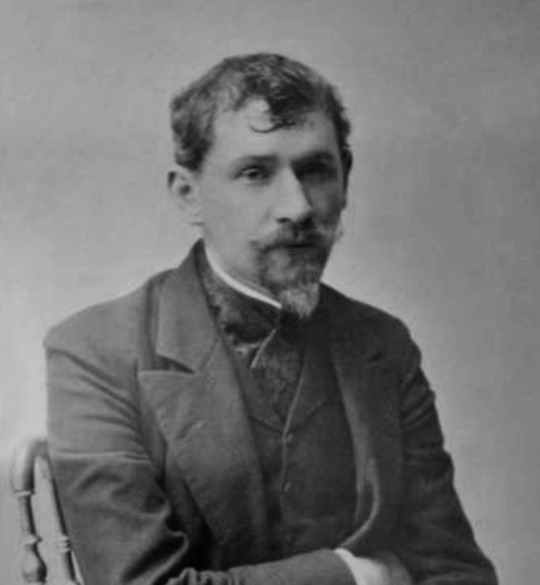
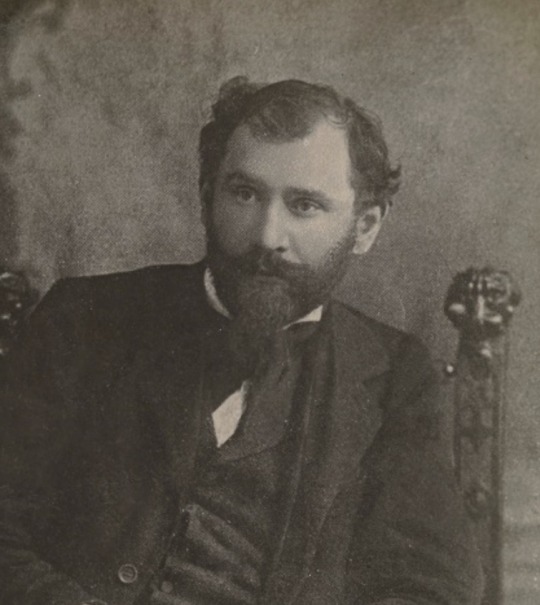
I think it's worth to note that Stanisław Przybyszewski, father of Stanisława Przybyszewska, was, aside from being one of the most influential modernist writers in scandinavian, german and cracovian circles, an absolute madlad. The insane highlights of his life include:
• Przybyszewski studied both medicine and architecture in Berlin. He never got a degree in either of those, as he was arrested and expelled from the university for being involved in working-class movements.
• His mysterious aura and reputation were seen as both terrifying and seductive. Przybyszewski will be involved in numerous love affairs that will also be mentioned in this post.
• His lover and mother of three of his children committed suicide while pregnant with the fourth one. The reason was lack of love and support received from her lover, who at the same time maintained a romantic relationship with another woman.
• He befriended many artists, including August Strindberg, Ola Hansson, Carl Ludwig Schleich. Most will later lose their good opinion on Przybyszewski.
• He was also buddies with Edvard Munch, who gifted him one version of The Scream and possibly painted it under the influence of Przybyszewski's work, Requiem Aeternam.
• The friendship was, however, troubled, as Przybyszewski seduced Dagny Juel, a Norwegian writer, pianist and a muse of many artists of their time, including Munch himself. Dagny married Przybyszewski, and all three artists appear in Munch's series, Jealousy.
• During the last year of their marriage, Przybyszewski had affairs with two women at the same time, while Dagny romanced at least three other men in Paris. One of them, Władysław Emeryk, would later shoot her dead in a hotel room after inviting both her and her husband to Tbilisi in 1901. It is suspected that Przybyszewski participated in plotting the murder.
• The two lovers of Przybyszewski were respectively Jadwiga Kasprowiczowa and a painter, Aniela Pająkówna. The later one will become the mother of Stanisława Przybyszewska.
• Przybyszewski's second wife, Jadwiga Kasprowiczowa, abandoned her children and husband (przybyszewski's friend and one of the most treasured polish poets of the time, Jan Kasprowicz) for Stanisław, with whom she immediately fell in love with. He was the direct cause for the couple divorcing.
•He was an occultist and practiced satanism. As an influential and popular writer he was always surrounded by crowds of curious fans, who were referred to as Children of Satan (referencing Przybyszewski's work with the same title). This dark aura made him being often called a demon or satan himself. To make it even more interesting, Dagny was sometimes portrayed as a vampire, even by Munch.
• Przybyszewski was known for huge parties he couldn't afford, hardcore drug use and alcoholism. He contributed to the morphine addiction of his daughter, Stanisława Przybyszewska.
• Przybyszewski's wife (Jadwiga) didn't approve of his contact with the child he had with another woman. In order to meet, Przybyszewski and his daughter Stanisława were meeting as lovers in hotel rooms.
293 notes
·
View notes
Text
Jersey Boys - Jukebox Musical Roundtable
Jersey Boys, directed by Clint Eastwood, follows the story of the 1960s rock 'n roll group The Four Seasons comprised of Frankie Valli, Bob Gaudio, Tommy DeVito, and Nick Massi. The film focuses on their rise to fame and the challenges they faced along the way.
youtube
What are the social aspects within the film’s narrative that align with the film’s songs?
Jersey Boys aligns its musical selections with key social aspects of its narrative, each song underscoring elements of the personal and communal evolution of the characters. Set against a backdrop of the 1960s—a time of cultural upheaval and musical revolution—the film focuses on the personal struggles and successes of The Four Seasons. For instance, songs like "Sherry" and "Big Girls Don't Cry" resonate with the youthful exuberance and working-class ambitions of the band members, reflecting their hopes and the societal push towards a new musical era that merged pop with personal storytelling. The track "My Eyes Adored You" reflects Frankie Valli's personal losses and his perseverance amidst family tragedies, portraying a deeper social context of personal resilience and commitment, a common theme of the era's socio-cultural fabric. Thus, the film’s songs not only enrich the narrative but also mirror the complex interplay between personal identity and broader societal shifts.
Mira discusses this narrative integration as a staple of successful musicals, highlighting how songs in traditional musicals often serve to express unspoken thoughts or pivotal emotional moments. Though Mira doesn't mention this directly, I find this tactic of musicals to be extremely efficient in advancing timelines without having to explicitly inform the audience of the jump. Similarly, a musical number can encapsulate a wide variety of emotions and plot information, similar to a montage. Jersey Boys employs this technique effectively during sequences like Frankie Valli's rendition of "Can't Take My Eyes Off You," which encapsulates his feelings of triumph and personal turmoil.
youtube
How do the historiographies of previously recorded songs inform audience relationships with the musical’s narrative and performers?
The historiography of The Four Seasons' songs plays a crucial role in Jersey Boys by creating a bridge between the audience and the narrative, enhancing the authenticity and emotional engagement. Songs like "Walk Like a Man" and "December, 1963 (Oh, What a Night)" carry with them a historical weight that informs and deepens the audience's understanding of the times and trials the characters endure. These songs, embedded in the cultural memory of many viewers, evoke nostalgia and a sense of realism, making the historical context of the film more relatable and vivid. The familiarity of the music invites the audience into a shared experience, transcending the screen to tap into collective memories and emotions, thereby strengthening the connection to the film's portrayal of the characters and their journey.
Furthermore, the film's narrative structure diverges from the typical linear progression of many musicals. It employs a documentary-style format with characters breaking the fourth wall to address the audience directly which contributes to the historiography. The idea is to include the audience in the storytelling as both makers and viewers reflect on the monumental rise of a beloved American music group. This method adds a layer of meta-narrative commentary, reflecting on the construction of musical mythos itself, which Mira notes as a modernist touch in contemporary musicals.
[SEE 4TH WALL BREAK IN TRAILER ABOVE]
What musical genre/style drives the film’s score, and how does the genre/style (re)define the film as a musical?
Jersey Boys is driven predominantly by the crooner, Doo-Wop, and Rock 'n' Roll styles that characterized the 1960s music scene, particularly influencing the American pop music landscape. This genre choice not only serves to set the period context but also redefines the musical film by integrating biographical and historical realism with the traditional elements of musical theatre. The use of genuine songs from The Four Seasons' catalog, performed in contexts that closely mirror the real-life circumstances under which they were popular, adds a layer of authenticity that is sometimes absent in more stylized musical films. This approach allows Jersey Boys to maintain a foot in the conventional musical genre while also exploring more nuanced, character-driven storytelling, emphasizing the impact of time, place, and societal change on personal and professional lives.
The blend of traditional and innovative elements in Jersey Boys suggests a potential path forward for the Hollywood musical genre, one that respects its roots while evolving to meet contemporary tastes. Mira argues that for musicals to stay relevant, they must adapt by incorporating new styles and addressing modern audiences' expectations, which are more attuned to realism and complexity. I largely agree. I think there is room for the more traditional whimsy of the Hollywood musical if it is housed within more complex themes such as the possibilities we covered in class (humor, delusion, hallucination, satire, etc.).
Jersey Boys demonstrates that the musical genre can successfully incorporate realistic storytelling and complex character development without sacrificing the emotive power of musical performances. The film's ability to appeal to both fans of traditional musicals and new audiences suggests a versatile blueprint for future projects within the genre. The successful integration of music and story, along with a modern narrative approach, may well encourage more filmmakers to explore and innovate within the musical genre, ensuring its survival and relevance in the modern cinematic landscape.
This approach, rooted in the dual adherence to tradition and innovation, not only honors the genre's history but also paves the way for its continued evolution, as discussed by Mira in the broader context of Hollywood musicals adapting to cultural shifts.
youtube
youtube
17 notes
·
View notes
Text
#OTD in 1882 – Birth of novelist, short story writer, and poet, James Joyce, in Dublin.
Born in Dublin, James Joyce, contributed to the modernist avant-garde and is regarded as one of the most influential and important authors of the 20th century.
James Joyce published ‘Portrait of the Artist’ in 1916 and caught the attention of Ezra Pound. With ‘Ulysses,’ Joyce perfected his stream-of-consciousness style and became a literary celebrity. The explicit content of his prose brought…

View On WordPress
#6 June#Éamon De Valera#Bloomsday#Dublin#Finnegan&039;s Wake#Fluntern cemetery#Ireland#Irish History#Italy#James Joyce#Leopold Bloom#Nora Barnacle#Paris#Ulysses#Writer#Zurich
10 notes
·
View notes
Text
Typographer Research -
Paul Renner
------------------------------------------------

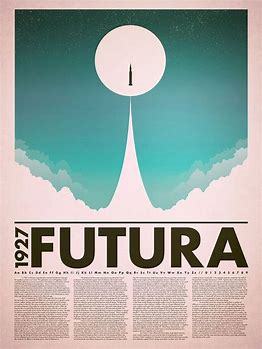
- - - - - - - - - - - - - - - - - - - - - -
Paul Renner, born in 1878, was a German graphic designer and typographer celebrated for his groundbreaking work in modern typography.
His most enduring legacy lies in the creation of Futura, an iconic typeface with its sleek lines and geometric simplicity.
- - - - - - - - - - - - - - - - - - - - - -
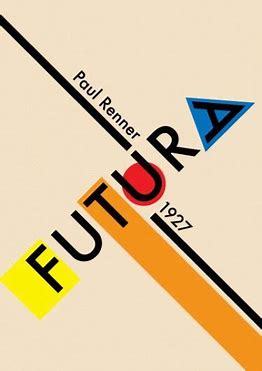
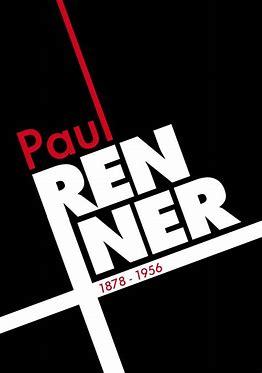
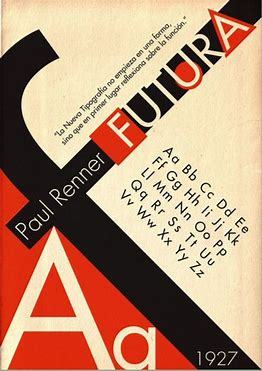
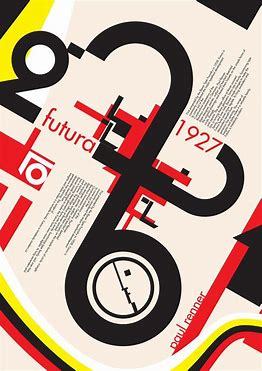
- - - - - - - - - - - - - - - - - - - - - -
In 1927, Renner introduced Futura.
Futura swiftly gained popularity, becoming synonymous with the Bauhaus movement and modernist design ethos.
During World War II, Paul Renner faced challenges due to his opposition to the Nazi regime's cultural policies.
His books were banned, and his printing press was confiscated. Despite these obstacles, Renner persevered, continuing to contribute to typography through writing and teaching.
- - - - - - - - - - - - - - - - - - - - - -
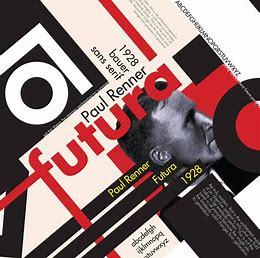
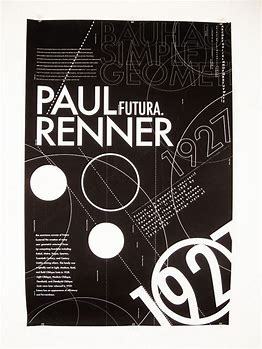
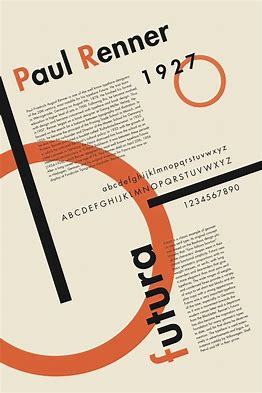
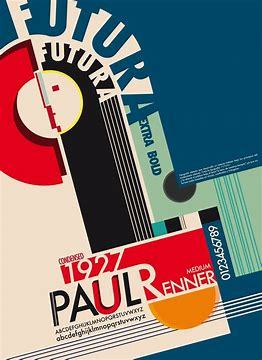
------------------------------------------------
#lsad#art#graphic designer#graphic design#poster#design#typography#text#font#futura#research#graphic art
7 notes
·
View notes
Text

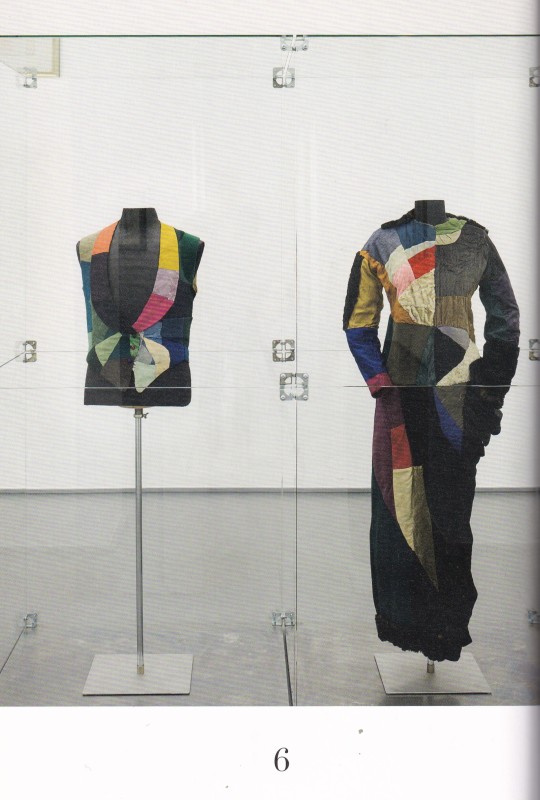
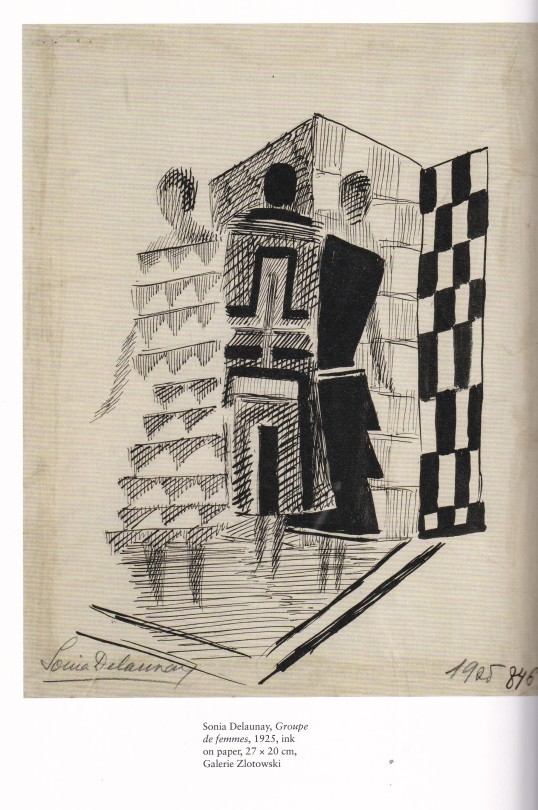
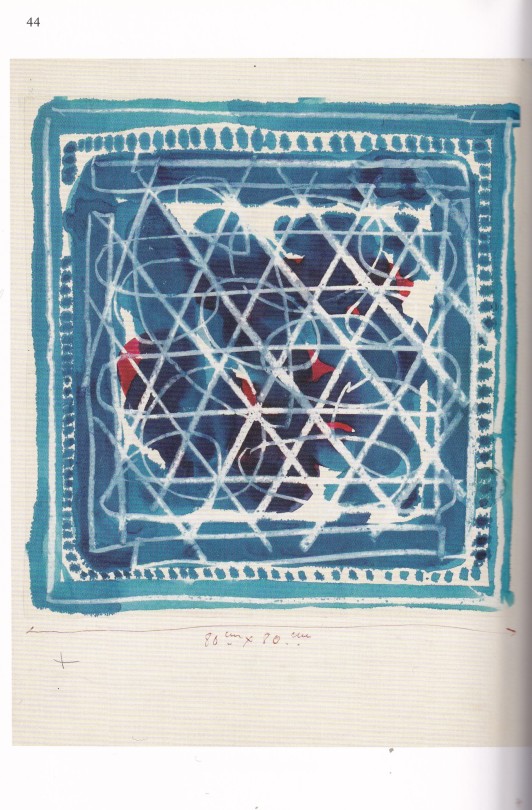


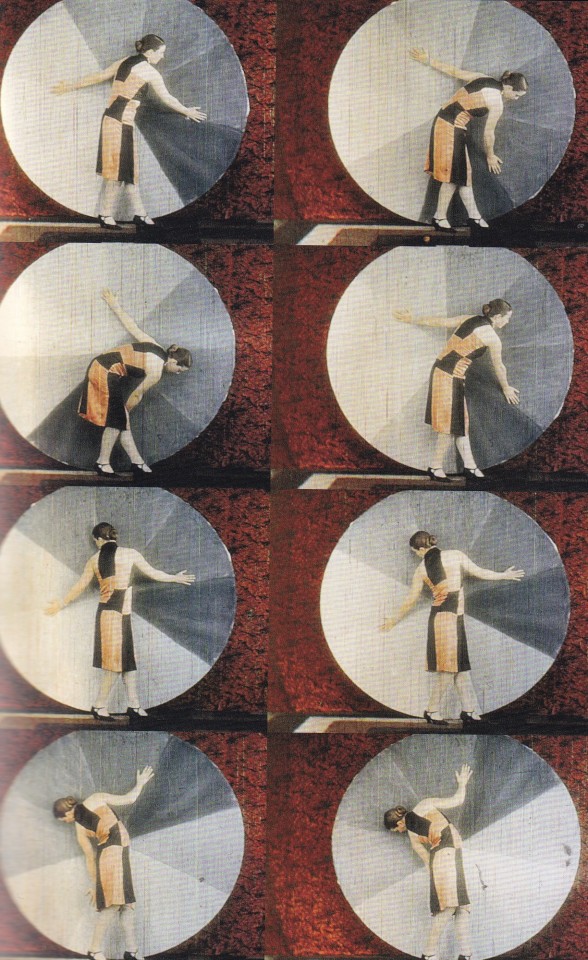
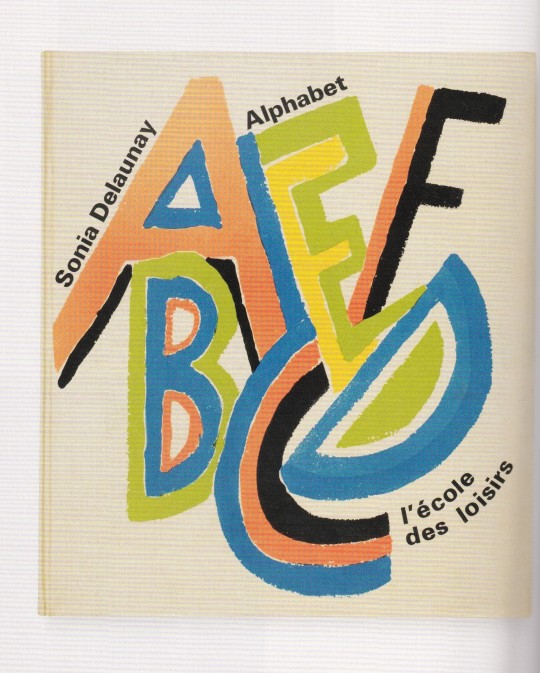

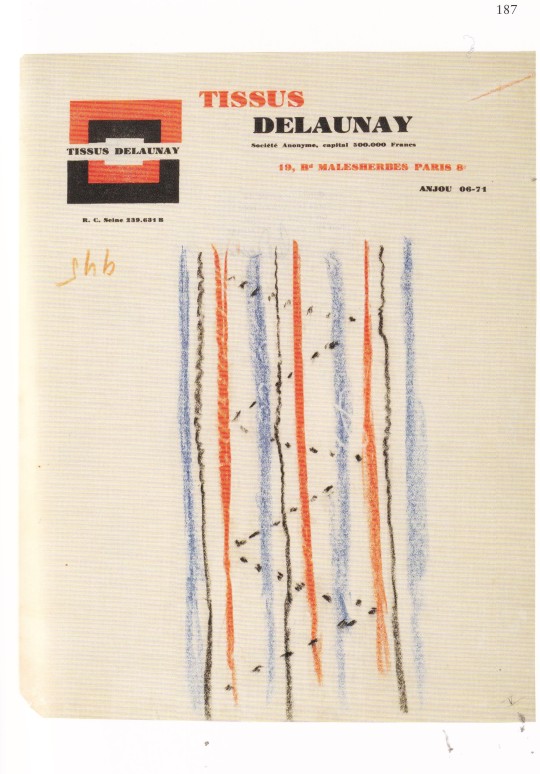
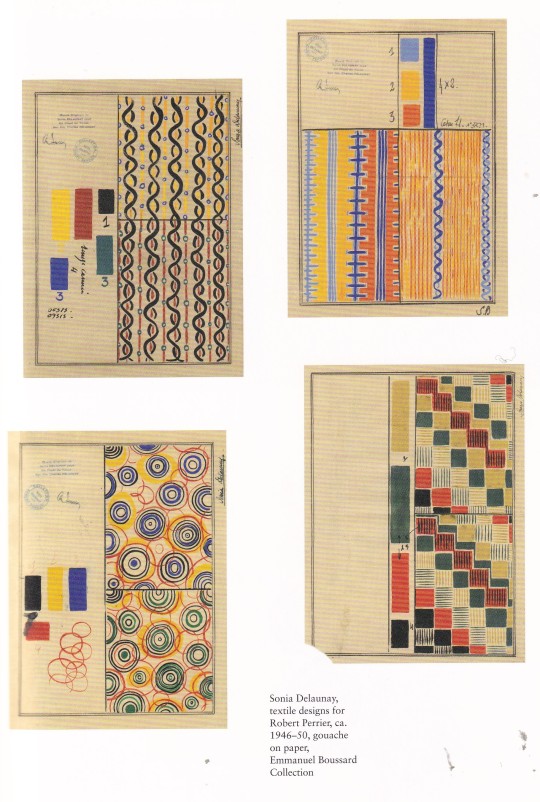
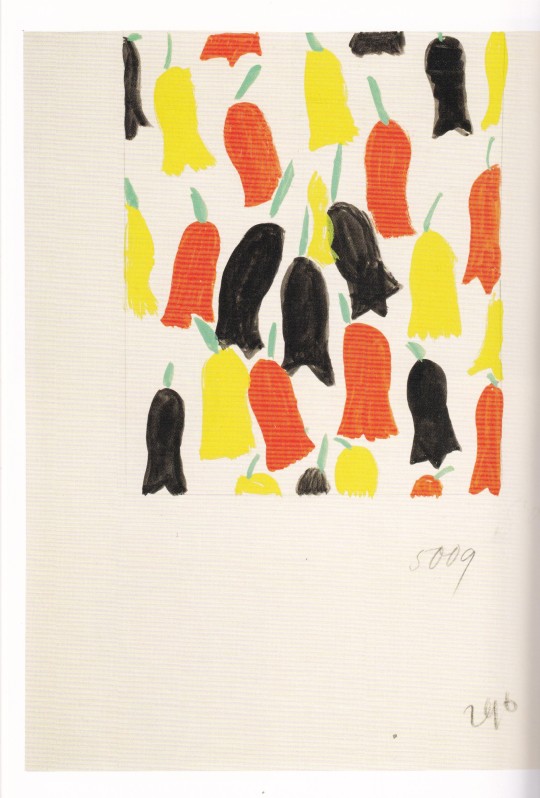

Maison Sonia Delaunay
Edited by Waleria Dorogova, Katia Baudin
with contributions by Norman Barreu-Gély, Emilie Hammem, Diane Muller-Tanquerey, Pascal Rousseau,Marketa Uhlirova, Margarete Zimmermann
Hatje Cantz, 2022, 233 pages, 17,5x24,8cm, ISBN 978-3-7757-5380-7
euro 57,00
email if you want to buy [email protected]
Exhibition Kunstmuseen Krefeld 23.10.2022-26.02.2023
How Sonia Delaunay expanded the colorful vocabulary of modernist abstraction into the realms of textiles and industrial design
This volume presents sketches and textile designs by the great Russian French modernist artist Sonia Delaunay alongside her paintings and interior and fashion designs. It demonstrates how she transferred her color philosophy of “Simultanism,” which she developed in her painting, to the mediums and surfaces of modern life. Maison Sonia Delaunay also explores the international textile companies with whom she collaborated, and shows how she explored the relationship between art and industry, and the ways in which she used her many abilities to design a visionary modern life. The book includes the first scholarly essays on Delaunay's collaborations with silk industrialist Robert Perrier and couturier Jacques Heim, who were among her most important collaborators.
Born in Odessa, Ukraine, Sonia Delaunay (1885–1979) migrated to Paris in 1906 and became a key figure in the city’s avant-garde scene. During these early years, her paintings underwent a formal shift influenced by the vivid colors of Fauvism. She soon met her husband, fellow artist Robert Delaunay, and the couple pioneered a fusion of Cubism and Neo-Impressionism that they termed Simultanism—abstract painting that uses color in a manner comparable to the use of sound and rhythm in music. In 1964, Delaunay became the first living woman artist to have a retrospective at the Louvre.
25/01/24
#Sonia Delaunay#art exibition catalogue#Kunstmuseen Krefeld 23.10.2022-26.02.2023#sketches#textile designs#fashion designs#fashionbooksmilano
8 notes
·
View notes
Photo
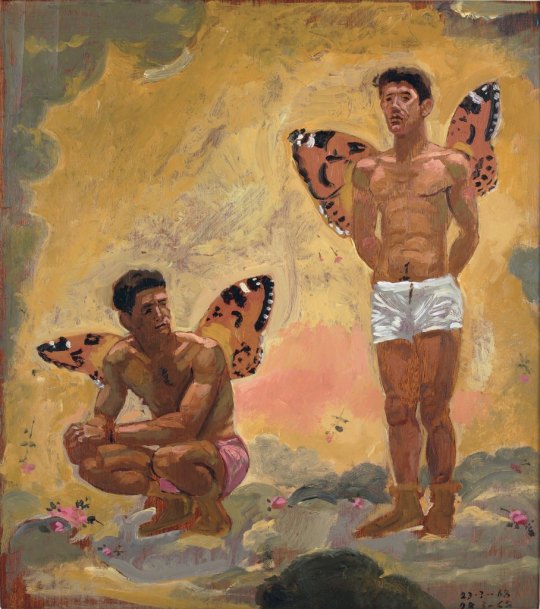

The Paintings of Yannis Tsarouchis
Yannis Tsarouchis is one of a group of twentieth-century Greek artists who portrayed and defined modern Greek identity. A sensual painter influenced by French Impressionism, Tsarouchis is a significant gay artist who painted images of vulnerable men and occasionally strong women.
Born in January of 1910 in Piraeus, Greece, Yannis Tsarouchis initially trained in the studio of Byzantine artist Fotis Kontoglou, an influential Greek modernist who introduced him to Byzantine iconography. He later studied at the Athens School of Fine Art, graduating in 1935, The major influence on Tsarouchis’ work, however, came from a trip to Paris, Istanbul, and Italy in the mid-1930s that exposed him to the bohemian lifestyle and both Renaissance and Impressionist art.
Tsarouchis’ work moved in two main directions: toward the orientalist and sensual, with strong influences from Matisse, and toward the ancient Greek ideal as expressed by the Renaissance and the Baroque movements. In doing so, Tsarouchis played a pivotal role, alongside his contemporaries, in portraying and shaping modern Greek identity.
Returning to a war-torn Greece in 1936, Tsarouchis become a soldier in the Greco-Italian war in 1940. With a more political and humanist perspective after his service, he began painting scenes of young men who were preparing to defend their homeland from the rise of Fascist Italy. Gay artist depiction of the soldiers and sailors was controversial; some of his exhibits were taken down by censors, who saw his work as unpatriotic and degrading to the Greek male image.
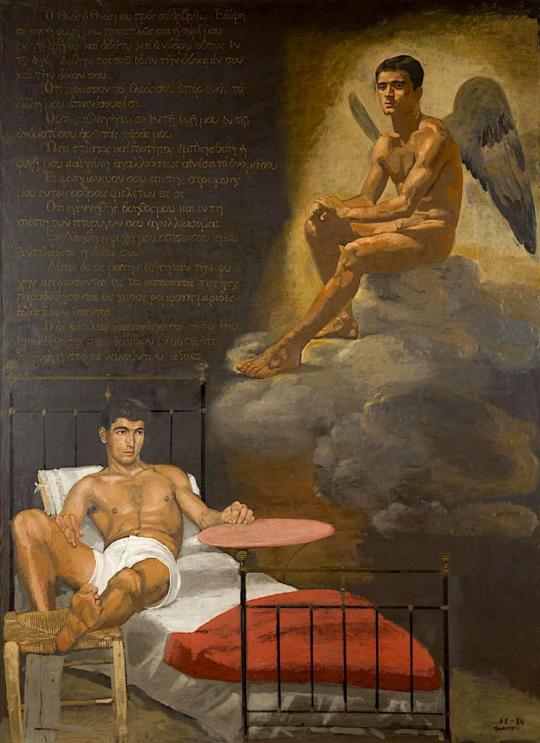
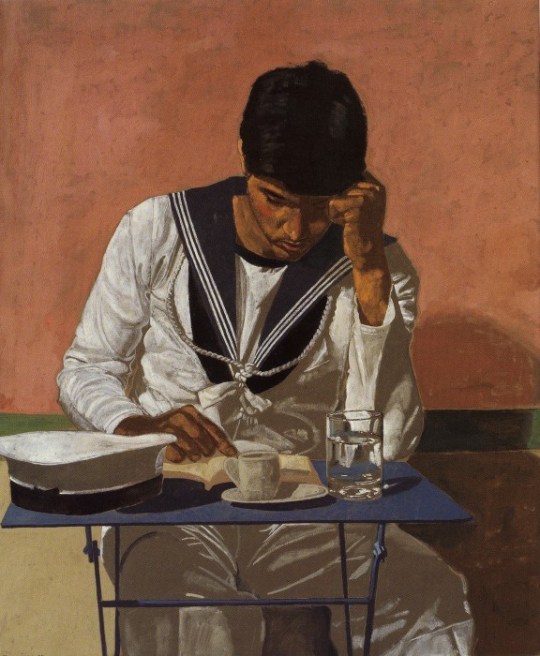


Tsarouchis’ paintings of soldiers and sailors he admired captured not only a Greek identity, but also a gay awareness. Transforming Rodin’s bronze statue into an icon for Greek culture, he painted his 1936 “The Thinker”, showing a modern young Greek sitting on a cafe stool, a cigarette in hand, with a faraway look in his eye. Among Tsarouchis’ other paintings are: the 1939 “Young Man Posing as an Olympic Statue”; “Sailor with Coffee Cup”painted in 1954; and the 1956 “Forgotten Guard”.
Yannis Tsarouchis established in 1949, along with other Greek artists including sculptor Nikos Nikolaou and seascape painter Panayiotis Tetsis, the “Armos” art group which worked to promote Greek traditional painting. In 1951 he had exhibitions in Paris and London and participated in the 1958 Venice Biennale. Gay artist moved to Paris in 1967 in a self-imposed exile to.wait out the years of military dictatorship in Greece.
During this exile, Tsarouchis designed theater sets for productions at Milan’s La Scala opera house, the Greek National Theater, the Dallas Opera, and London’s Covent Gardens, as well as the annual Avignon Art Festival in France. He also designed sets and costumes for films by Jules Dassin and Michael Cacoyannis. After his return to Greece in the middle of the 1970s, he designed an acclaimed operatic set for director Franco Zeffirelli’s production of Italian classical composer Luigi Cherubini’s comedic opera “Médée” at the ancient amphitheater at Epidauros.
Residing in northern Athens at the age of seventy nine, Yannis Tsarouchis died on July 20th of 1989. The Yannis Tsarouchis Museum, an art collection hosted in the artist’s home in Maroussi, Athens, was officially opened in 1982 in recognition of Tsarouchis’ contributions and respect for Greek culture. Upon the reading of his will and testament, it was found that Tsarouchis bequeathed all his assets to the Yannis Tsarouchis Foundation.

195 notes
·
View notes
Text
Deutschribing Germany
Landmarks
Germany is the third country in the world with the highest number of World Heritage Sites: fifty-one in total, of which forty-eight are cultural and three are natural.

Aachen Cathedral
The Aachen Cathedral is a Roman Catholic church in Aachen, North Rhine-Westphalia. It is one of the oldest cathedrals in Europe and was consecrated in 805. Emperor Charlemagne was buried there.
The cathedral has two distinct architectural styles and small portions of a third. The core is Carolingian-Romanesque, the choir was constructed in the Gothic style, and the area around the throne is Ottonian.
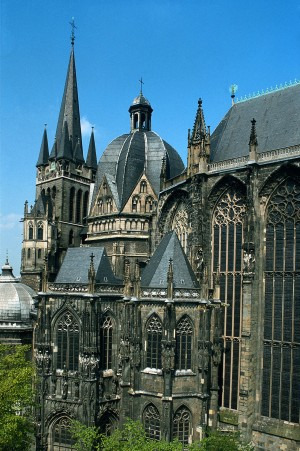
Abbey and Altenmünster of Lorsch
The Lorsch Abbey is a former imperial abbey in Lorsch, Hesse. It was founded in 764 and was one of the most renowned monasteries of the Carolingian Empire. Although in a ruined state nowadays, its remains are among the most important pre-Romanesque-Carolingian style.
The abbey combines the Roman triumphal arch (arch-shaped passageways and half-columns) with the vernacular Teutonic heritage (baseless triangles of the blind arcade and polychromatic masonry).

Ancient and Primeval Beech Forests of the Carpathians and Other Regions of Europe
The Ancient and Primeval Beech Forests of the Carpathians and Other Regions of Europe is a transnational serial nature site that includes forests in Albania, Austria, Belgium, Bulgaria, Croatia, Germany, Italy, Romania, Slovakia, Slovenia, Spain, and Ukraine.
It encompasses 94 forests of European beech, which in many cases have grown without interference since the last ice age. Those in Germany are located in Brandenburg, Hesse, Mecklenburg-Vorpommern, and Thuringia.

Archaeological Border complex of Hedeby and the Danevirke
Hedeby was an important Danish Viking Age trading settlement between the 8th and 11th centuries, now in Busdorf, Schleswig-Holstein. It was rediscovered in the late 19th century.
The Danevirke or Danework is a system of Danish fortifications in Schleswig-Holstein initiated in 650 and expanded during the Viking Age and High Middle Ages.

Bauhaus and its Sites in Weimar, Dessau and Bernau
Bauhaus and its Sites in Weimar, Thurngia; Dessau-Roßlau, Saxony-Anhalt, and Bernau bei Berlin, Brandenburg, comprises six separate sites associated with the Bauhaus art school, which was in operation between 1919 and 1933.
The buildings are fundamental representatives of Classical Modernism and Art Nouveau. Some of them were built as social housing, others operated as schools, and the rest of them were residential buildings.

Bergpark Wilhelmshöhe
Bergpark Wilhelmshöhe is a landscape park in Kassel, Hesse. It is the largest European hillside park and the second-largest park on a hill slope in the world. Construction began in 1689 and lasted 150 years.
The park has Baroque buildings and unique fountains and water features. At the summit stands the Hercules monument, a 40-meter-high pyramid with an 8.5 meter bronze statue of Hercules.

Berlin Modernist Housing Estates
The Berlin Modernist Housing Estates site comprises six separate subsidized housing estates in Berlin. It dates from the Weimar Republic (1919-1933).
The estates are examples of the building reform movement that contributed to improving housing and living conditions of people and also provide exceptional examples of new urban and architectural typologies, as well as technical and aesthetic innovations.

Carolingian Westwork and Civitas Corvey
The Princely Abbey of Corvey is a former Benedictine abbey consecrated in 844 and located in Höxter, North Rhine-Westphalia. It was one of the self-ruling princely abbeys of the Holy Roman Empire.
An example of Carolingian architecture, it is the oldest surviving example of a westwork, whose inside contains the only known wall paintings of ancient mythology with Christian interpretation in Carolingian times.

Castles of Augustusburg and Falkenlust at Brühl
The Ausgustusburg and Falkenlust Palaces form a historical building complex in Brühl, North Rhine-Westphalia. The buildings are connected by the spacious gardens of the Schlosspark.
Built in the early 18th century, the palaces and gardens are masterpieces of early Rococo architecture. They are now used as a venue for concerts.

Caves and Ice Age Art in the Swabian Jura
The Caves and Ice Age Art in the Swabian Jura are a collection of six caves in the Swabian Alps, in Baden-Württemberg, which were used by Ice Age humans for shelter about 33,000 to 43,000 years ago.
Within the caves were found the oldest non-stationary works of human art in the form of carved animal and humanoid figurines, in addition to the oldest musical instruments ever found.

Classical Weimar
Classical Weimar consists of eleven sites in and around Weimar, Thuringia. The city was a cultural center of the Enlightenment during the 18th and 19th centuries, where many notable writers and philosophers, including Christoph Martin Wieland, Friedrich Schiller, John Gottfried Herder, and Johann Wolfgang von Goethe, lived and participated in the Weimar Classicism movement.
It includes the church of St. Peter and Paul, Duchess Anna Amalia Library, Goethe's house, Herders residence, the historical cemetery, Park an der Ilm, Schiller's house, Schloss Belvedere, Schloss Ettersburg, Schloss Weimar, Tiefurt House, Wilhelm-Ernst-Gymnasium, and Wittumspalais.

Collegiate Church, Castle, and Old Town of Quedlinburg
Quedlinburg was an influential and prosperous trading center during the early Middles Ages and a center of influence under the Ottonian dynasty.
Quedlinburg Abbey was a house of secular canonesses in Quedlinburg, Saxony-Anhalt. It was founded in 936 on the initiative of Saint Mathilda, the widow of King Henry the Fowler, as his memorial. The castle, abbey, church, and surrounding buildings are masterpieces of Romanesque architecture.

Cologne Cathedral
The Cologne Cathedral is a Catholic cathedral in Cologne, North Rhine-Westphalia. Construction began in 1248 but was halted in 1560; the cathedral was not completed until 1880.
It is a renowned monument of Gothic architecture and the largest Gothic church in Northern Europe, with the second-tallest spires. It is also the third-tallest church in the world.

Darmstadt Artists' Colony Mathildenhöhe
The Darmstadt Artists' Colony refers to a group of Jugendstil artists as well as to the buildings in Mathildenhöhe in Darmstadt, Hesse, where the artists lived in the 19th and 20th centuries.

They were financed by patrons and worked together with other members of the group with similar artistic tastes.
Erzgebirge/Krušnohoří Mining Region
The Ore Mountains—Erzgebirge in German and Krušnohoří in Czech—lie along the Czech-German border in Bohemia and Saxony, respectively, and the site is shared between the Czech Republic and Germany.

The region was the setting of the earliest stages of the early transformation of mining and metallurgy from a craft to a large-scale industry. As a result, mining directly shaped the landscape and the habitats of plants and animals.
Fagus Factory in Alfeld
The Fagus Factory is a shoe last factory in Alfeld on the Leine, Lower Saxony. It is an important example of early modern architecture.

The factory was commissioned by Carl Benscheidt, who wanted a radical structure that expressed the company's break from the past. It was built between 1911 and 1913.
Frontiers of the Roman Empire
Limes is the term used to refer to the Germanic border defense or delimiting system marking the borders of the Roman Empire and separating the empire from the unsubdued Germanic tribes between the years 83 and 260.
The Limes Germanicus are the fortifications that bounded the ancient Roman provinces of Germania Inferior, Germania Superior, and Raetia, in modern-day southwestern North Rhine-Westphalia and southwestern and southern Germany. Their total length was 568 km, and they included sixty forts and 900 watchtowers.
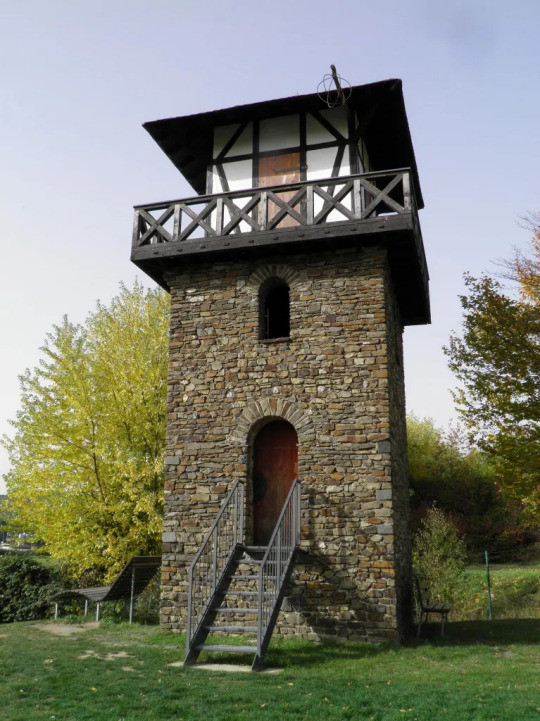
Frontiers of the Roman Empire in Bavaria
The Danubian Limes refers to the Roman military frontier along the Danube in Bavaria, as well as Austria, Bulgaria, Croatia, Hungary, Romania, Serbia, and Slovakia.
The border was reinforced with watchtowers, legion camps, and forts built around the first century. A Roman road, the Danube Way, was laid along the limes.

Garden Kingdom of Dessau-Wörlitz
The Dessau-Wörlitz Garden Realm is a cultural landscape between Dessau and Wörlitz in Saxony-Anhalt. It was created in the late 18th century and is one of the largest English parks in continental Europe.

It was designated as a world heritage site because of its exceptional landscape design and testimony to the ideals of the Enlightenment Age.
Great Spa Towns of Europe
The Great Spa Towns of Europe is a transnational site that includes eleven spa towns across several European countries, namely, Austria, Belgium, Czech Republic, France, Germany, Italy, and the United Kingdom.
Those in Germany are Bad Ems, Rhineland-Palatinate; Baden-Baden, Baden-Württemberg, and Bad Kissingen, Bavaria. All the spa towns were developed around natural mineral water springs.

Hanseatic City of Lübeck
The Hanseatic City of Lübeck, located in Schleswig-Holstein, is the second-largest city on the German Baltic coast. It was founded before 819 by Polabian Slavs and became the cradle and capital city of the Hanseatic League.
Nicknamed the "City of Seven Towers", its historic old town includes five Protestant churches with seven towers: the Lübeck Cathedral, St. Giles's, St. Jacob's, St. Mary's, and St. Peter's, as well as the Burgkloster, the Koberg site, the town hall, and the market square.

Historic Centers of Stralsund and Wismar
The Hanseatic City of Stralsund is located in Mecklenburg-Western Pomerania and is the oldest city in Pomerania. The Strelasund Crossing connects the city with Rügen, the largest island of Germany. Its old town was inscribed as a UNESCO World Heritage Site alongside Wismar because of its Brick Gothic buildings and importance in the Hanseatic League.
The Hanseatic City of Wismar is also located in Mecklenburg-Western Pomerania. Its historical old town includes the churches of St. George's, St. Mary's, and St. Nicholas's.
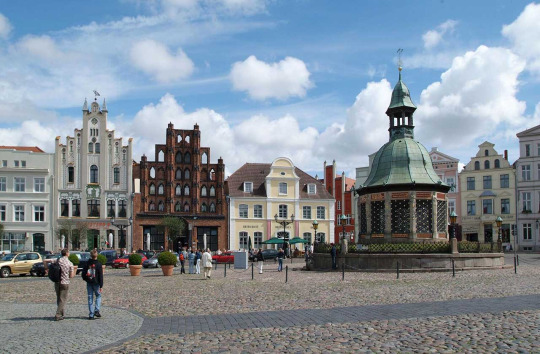
Luther Memorials in Eisleben and Wittenberg
Eisleben, in Saxony-Anhalt, was the hometown of Martin Luther, and he even preached his last sermon and died there. His Birth and Death houses are a UNESCO World Heritage Site. The town was first mentioned in the late 10th century.
Wittenberg is also famous for its close connection with Luther, as he lived in the Augustinian monastery. It was also one of the most powerful cities in the Holy Roman Empire as the seat of the Elector of Saxony.

Margravial Opera House Bayreuth
The Margravial Opera House is a Baroque opera house in Bayreuth, Bavaria. It was constructed according to the plans designed by the French architect who built the court of Hohenzollern margrave Frederick of Brandenburg-Bayreuth.
The façade was inspired by the Place Vendôme in Paris and has large Corinthian columns. A balustrade is stretched across the façade, with sculptures of Apollo, Minerva, and six Muses placed atop.

Maulbronn Monastery Complex
The Maulbronn Monastery is a former Cistercian abbey and ecclesiastical state in Maulbronn, Baden-Württemberg.

Founded in 1147, the complex is surrounded by turreted walls and a tower gate. Today it houses the town hall and a police station. The monastery contains an Evangelical seminary and a boarding school.
Messel Pit Fossil Site
The Messel pit is a quarry near Messel, in Hesse. Before it fell into disuse, bituminous shale was mined there. Besides its mineral significance, it also has significant geological and scientific importance due to the abundance of well-preserved fossils and diversity of plants and animals found there.

The site almost became a landfill, but strong local resistance stopped these plans and the site was declared a World Heritage Site. Since then, discoveries about the early evolution of mammals and birds are still being made.
Mines of Rammelsberg, Historic Town of Goslar and Upper Harz Water Management System
The Rammelsberg is a mountain south of Goslar, Lower Saxony, where an important silver, copper, and lead mine is located. Before its closure in 1988, it was the only mine still working continuously for over 1,000 years.
Goslar's political importance for the Holy Roman Empire and its testimony to the history of ore mining contributed to making them a UNESCO World Heritage Site. The Upper Harz Water Regale is a system of dams, reservoirs, and ditches built between the 16th and 19th centuries to store the water that drove the water wheels of the mines, including those in Rammelsberg.

Monastic Island of Reichenau
The Reichenau Island is located in Lake Constance, Baden-Württemberg. It is connected to the mainland by a causeway and a low road bridge.
In 724, the first monastery was built on the island, and Reichenau became an influential religious, cultural, and intellectual center. The Reichenau Abbey was one of the most significant monasteries in the Frankish Empire.

Museum Island, Berlin
The Museum Island in Berlin is a museum complex on the northern part of the Spree Island. It was built between 1830 and 1930 by order of the Prussian kings.
The island consists of the Altes Museum (old museum), Neues Museum (new museum), Alte Nationalgalerie (old national gallery), the Bode-Museum, and the Pergammonmuseum, as well as the Berlin Cathedral.
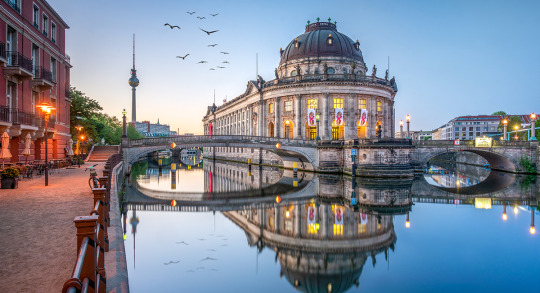
Muskauer Park/Park Mużakowski
The Muskau Park—Muskauer Park in German and Park Mużakowski in Polish—is a landscape park in Upper Lusatia, a region between Germany (Saxony) and Poland.
The site forms the largest English gardens in Central Europe and was laid out from 1815 onward. Its utopian design incorporates both native plants and the nearby town.
Naumburg Cathedral
The Naumburg Cathedral is located in Saxony-Anhalt. It dates from the 13th century and is a renowned landmark of the German Romanesque.
The west choir, the donor portrait statues of the twelve founders, and the rood screen are significant early Gothic monuments.
Old Town of Regensburg with Stadtamhof
Regensburg, in Bavaria, was an imperial Roman river fort and the political, economic, and cultural center of the surrounding region.
Its medieval center was made a World Heritage Site because of its well-preserved architecture, being the biggest medieval city north of the Alps, and historical importance for assemblies during the Holy Roman Empire.
Palaces and Parks of Potsdam and Berlin
The Palaces and Parks of Potsdam and Berlin site is a group of palace complexes and landscaped gardens in the Havelland region around Berlin and Potsdam.
Among others, the site includes the Palace and Park of Sanssouci, Neuer Garten (New Garden), Marmorpalais (Marble Palace), Cecilienhof Palace, Glienicke Palace, Park Glienicke, Nikolskoe log house, Pfaueninsel (Peacock Island), and Jagdschloß Glienicke (Glienicke hunting lodge).
Pilgrimage Church of Wies
The Pilgrimage Church of Wies is an oval Rococo church located in the foothills of the Alps in the town of Steingaden, Bavaria. It was built in the late 1740s by the Zimmermann brothers after a miracle allegedly happened there.
In 1738, tears were seen on a wooden figure of Christ at the Column. This resulted in a pilgrimage rush to see the sculpture, which led to the construction of a small chapel to house the statue. The chapel was soon expanded due to the large number of pilgrims it attracted.
Prehistoric pile dwellings around the Alps
The prehistoric pile dwellings around the Alps are a series of prehistoric stilt houses settlements in the Alps built between 5,000 and 500 BCE on the edges of lakes, rivers, or wetlands.
The UNESCO site includes 111 dwellings in Switzerland (56), Italy (19), Germany (18), France (11), Austria (5), and Slovenia (2). Excavations conducted at some of the sites have yielded important evidence regarding prehistoric life.
Roman Monuments, Cathedral of St. Peter and Church of Our Lady in Trier
The Roman Monuments, Cathedral of St. Peter and Church of Our Lady in Trier, Rhineland-Palatinate, demonstrate the political, economic, and historical importance of Trier in the Roman Empire.
The site includes the Aula Palatina, Barbara Baths, Church of Our Lady, High Cathedral of Saint Peter, Igel Column, Imperial Baths, Moselle Bridge, and Porta Nigra.
ShUM cities of Speyer, Worms and Mainz
The ShUM cities site refers to three Jewish communities in Rhineland-Palatinate: Shpira (Speyer), Warmaisa (Worms), and Magenza (Mainz). They were cultural centers of Jewish scholarship and of great importance for Ashkenazi Judaism.
Speyer contains some of the oldest and best-preserved Jewish buildings in its Jewish courtyard, while Worms has the oldest surviving in situ cemetery in Europe. Unfortunately, the city of Mainz, like many other places around the world, was the site of persecution and massacres against Jewish people.
Speicherstadt and Kontorhaus District
The Speicherstadt ("City of Warehouses") and Kontorhaus District are located in Hamburg. The Speicherstadt, where buildings stand on oak-pile foundations, is the largest warehouse district in the world. An example of Neo-Gothic and modernist architecture, the district was built as a free zone to transfer goods without paying customs.
The Kontorhaus District is the southeastern part of the old town. It is characterized by large office buildings in the style of Brick Expressionism. The area is densely built-up with many narrow alleys.
Speyer Cathedral
The Imperial Cathedral Basilica of the Assumption and St. Stephen is located in Speyer, Rhineland-Palatinate. The cathedral was built in the 11th century and features a triple-aisled vaulted basilica of red sandstone.
It is the largest Romanesque church in the world and is the burial site of several Salian, Hohenstaufen, and Habsburg emperors and kings.
St. Mary's Cathedral and St. Michael's Church at Hildesheim
The Cathedral of the Assumption of Mary is a medieval Roman Catholic cathedral in Hildesheim, Lower Saxony. It was built between 1010 and 1020 in the Romanesque style.
The Church of St. Michael is an early-Romanesque church in Hildesheim. Built in the 11th century, it is now a shared church, the main church being Lutheran and the crypt being Roman Catholic.
The Architectural Work of Le Corbusier, an Outstanding Contribution to the Modern Movement
The Architectural Work of Le Corbusier site consists of seventeen Modernist buildings in three continents by architect Le Corbusier.
The Weissenhof Estate is a housing estate in Stuttgart, Baden-Württemberg, and one of Le Corbusier's designs. It was built for an exhibition to showcase modern architecture's aspiration to provide cheap, simple, efficient, and good-quality housing.
Town Hall and Roland on the Marketplace of Bremen
The Bremen City Hall is one of the most important examples of Brick Gothic and Weser Renaissance architecture in Europe. Built in the 15th century, it is located on the market square.
Directly in front of it is the statue of Roland, which depicts the paladin of the first Holy Roman Emperor Charlemagne and hero of the Battle of Roncevaux Pass. It was erected in 1404 and the oldest surviving example.
Town of Bamberg
Bamberg is a town in Bavaria that dates back to the 9th century. It was a key link with the Slavs, especially those of Pomerania and Poland, and was briefly the center of the Holy Roman Empire.
Its medieval streets and buildings and historical significance were behind its designation as a UNESCO World Heritage Site.
Upper Middle Rhine Valley
The Upper Middle Rhine Valley or Rhine Gorge is a 65 km section of the Rhine between Koblenz and Rüdesheim in Rhineland-Palatinate and Hesse.
The rocks that form the landscape were laid down during the Paleozoic era and are known as Rhenish Facies, a type of fossil-bearing sedimentary rock mainly consisting of slate.
Völklingen Ironworks
The Völklingen Ironworks is a former blast-furnace complex in Völklingen, Saarland. Pig or crude iron production occurred at the site between 1882 and 1986.
It is one of the few intact ironworks surviving in Europe and North America and a testimony to ferrous metallurgy and the Industrial Revolution.
Wadden Sea
The Wadden Sea is an intertidal zone in the southeastern part of the North Sea, which borders Bremen, Hamburg, Lower Saxony, and Schleswig-Holstein.
It lies between northwestern continental Europe and the low-lying Frisian Islands, forming a shallow body of water with tidal flats and wetlands. The site has a high biological diversity and is an important area for breeding and migrating birds.
Wartburg Castle
The Wartburg is a medieval castle in Eisenach, Thuringia. It was the home of St. Elisabeth of Hungary and the place where Martin Luther translated the New Testament.
The castle's structures date from the 12th through 15th centuries, but the interior only goes back to the 19th century. It was an important inspiration for the Neuschwanstein Castle.
Water Management System of Augsburg
The Water Management System of Augsburg is located in the city of Augsburg, Bavaria, which is one of Germany's oldest cities, founded by the Romans.
The city's water management system has unique medieval canals and water towers and is testimony to the development of hydraulic engineering.
Würzburg Residence with the Court Gardens and Residence Square
The Würzburg Residence is a palace in Würzburg, Bavaria, whose interiors are masterworks of Baroque and Rococo architecture and art, including the largest fresco in the world.
Built in the 18th century, the residence includes large gardens in the Baroque and English garden styles.
Zollverein Coal Mine Industrial Complex
The Zollverein Coal Mine Industrial Complex is a former industrial site in Essen, North Rhine-Westphalia. The first mine was founded in 1847 and the last one closed in 1986.
The two parts of the site ranked among the largest of their kinds in Europe and were built in the New Objectivity style.
12 notes
·
View notes
Text
Something I find interesting as I delve deeper into different mediums of The Sandman is the way that Dream's appearance is used as a literary device. I don't remember whether I've discussed it here or not, but throughout the comics, his outfits serve as an indicator of his outward emotions and attitude while the style of the artist is often used to depict some aspect of his internal, unspoken emotional turmoil/peace. This carries over to the audiobook, though without the graphic aspect inherent to the original medium, it manifests in an interesting way through narration and further solidifies this interpretation of significance.
I had to start on Volume II for *cough* reasons, and the usage of detail is quite similar to other works by Gaiman, in that they are only included where it is important. He doesn't hit you over the head with scenery at every chance, it's carefully slotted into the scene at the points where it is most necessary and poignant, with the depth of these descriptions being directly tied to the importance that you, the listener, understand. We only hear that the random park is peaceful in the soundscaping because the park itself serves no purpose beyond that, but we get a couple paragraphs of description of Hell because it is vitally important we understand the scale and intensity of the horrors found there; setting is only acknowledged when it contributes to the narrative. This is echoed in The Sandman: Annotated, where we get some notes in the script regarding artistic choices—many of which are gestural, some of which are very detailed so that the artist may understand from this where their (and by extension the reader's) attentions must be drawn, which provides a sort of visual pacing.
To draw my point in a bit, Dream's castle follows this rule as an extension of his will and selfhood. It changes often to reflect what facet of himself he wants to convey outward most directly; appearing first as a rather low set, art nouveau affair with perhaps a silly bit of phallic imagery, then a gothic castle atop a mountain, most clearly establishing things when he puts it at the needlepoint top of a physically impossible peak covered in turrets and rooflines which jab into the air forbiddingly during Season of Mists as he contemplates the Key. When Dream is settled, the Dreaming is as well, when he is tumultuous, such follows. We don't get blow by blow descriptions, only when it is necessary.
Now that the visual language has been established and connected (insofar as I really can with the allotted mental energy for a tumblr post, however much of a passion project this may be, I am tired), it can be connected to Dream himself. His character design is very intentional, it reflects the post-punk, modernist take on its themes through his incredibly goth Look—he has the big, messy hair and impossibly white skin, dark clothes and dramatic fashion sensibilities—but beyond that, it reflects what feeling we are supposed to get from him. Morpheus' sense of self is ridiculously deeply tied to expectaction and perception of others, his entire personhood is based on what they expect. Despite this, to his infinite chagrin it seems, he has a personal identity sitting at his core that we see in his "natural" versus "put on" appearance (for lack of better terms): he's quiet and withdrawn but highly passionate and caring with all of the expected emotional regulation issues we would expect of someone with these temperaments they desperately repress; What he can control (clothes and hair) are utilized similarly to the castle, conveying his outward intention—think his driving outfit in Brief Lives versus his family dinner outfit in Season of Mists versus his final outfit in the Kindly Ones—where the things he cannot consciously seem to control are disguised by him, but utilized by art or narration to make a statement on his surroundings and feelings—think again of those outfits, of what his behavior means through that lens, what is conveyed through detail and silhouette.
What these more consistent physical attributes say is quite interesting, and quite revealing: Dream is not that scary. Sure his eyes will make you feel like you've stared down the cosmos and felt god touch your soul, but beyond that? Really? He's just a dude. A beautiful and strange one, but really nothing especially imposing. He's tall, but that effect is sort of diminished by his slight build. His face is angular and ethereal, but often careworn or haggard as well in a way I would compare to a very old and very poorly maintained stone statue. What this means to me is that Dream was never meant to be this frightening and imposing figure, that this was a choice made by the active individual we know exists because he is the one telling us about this all! A choice against his own nature that is concealed as often, swiftly, and mistakenly as his internal nature. This is, to conclude my point, supported by where these aspect of his appearance are given weight through art and narration. We only hear about his stature when he's sad or scared, only hear about his inhumanly pale skin when faced against the more beautiful aspects of personhood or mortality, only hear about his eyes when he uses them to scare or comfort.
These details of appearance are as woven into the narrative as any plot point, and used as any theme; which makes sense, he is the Prince of Stories afterall.
#as always i am crossing my fingers this makes sense#it is almost midnight right now and i have to be up at 6am tomorrow SO#this is all you guys get#for now...#i did this only because the ADHD forcibly grabbed my brain control panel and popped this sucker out in like an hour#i do not control the gremlin. i merely leash it and pray.#i have so many thoughts about this topic holy shit i love how details are used in gaiman's works i love the attention that qent into#everything in this series it is an Obsession Joy Land for people know too much about too much#so much effort and care went into this swries that it is genuinely mindblowing#so now i get to sit like a little gremlin and disect the art architecture setting fashion and mythology of this series so happy and long!#farewell besties#time for the organization tags#dream of the endless#the sandman#the sandman meta#spoilers for the sandman#minorly#raspberry tart
30 notes
·
View notes
Text

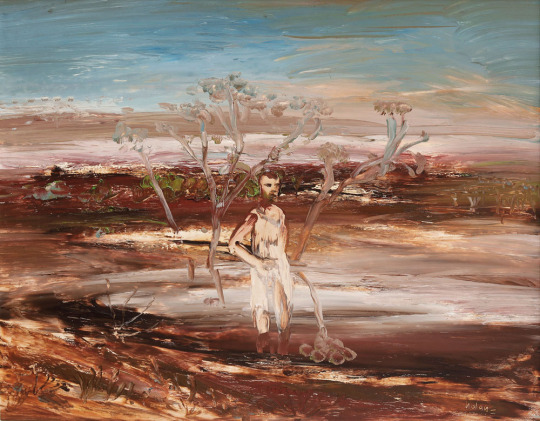
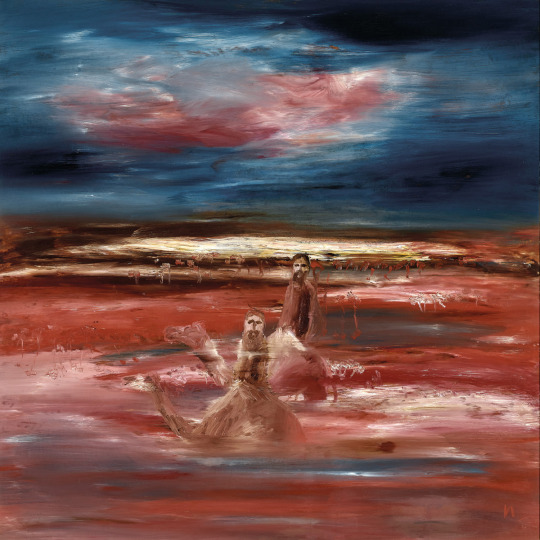

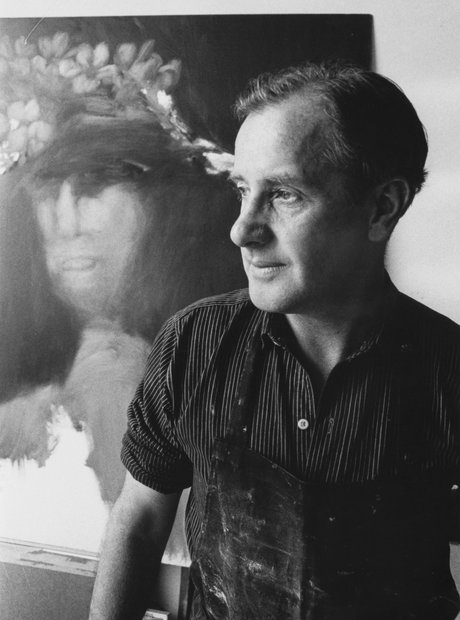
Sidney Nolan (1917 - 1992) was one of Australia’s most significant modernist artists, best known for his depictions of the history and mythology of bush life in Australia. His paintings, often rich in colour, striking in composition and deliberately awkward in technique, represent Australian stories of loss, failure and capture, featuring figures such as the bushranging Kelly Gang, shipwreck victim Eliza Fraser and the explorers Burke and Wills. Nolan’s iconic paintings of the Kelly Gang contributed to the development of the image of Ned Kelly as a symbol for Australian history and identity.
In 1948, Kenneth Clark, Slade Professor at Oxford, was visiting Australia and urged Nolan to travel in Europe. Nolan left for London in 1951 and spent extended periods in Greece and the USA. He continued to work on his early subject matter throughout his career, returning almost obsessively to the Kelly Gang, Eliza Fraser and Burke and Wills, for example in Burke 1962. He also worked often as a designer for theatre and opera productions, including Samon et Dalila and The abduction from the Seraglio in 1987 at Covent Garden, London and Il trovatore for the Australian Opera in 1983. Nolan was knighted in 1981 and made an associate member of the Royal Academy of Arts (UK) in 1987 and a companion of the Order of Australia in 1988.
https://www.artgallery.nsw.gov.au/.../artists/nolan-sidney/
11 notes
·
View notes
Text
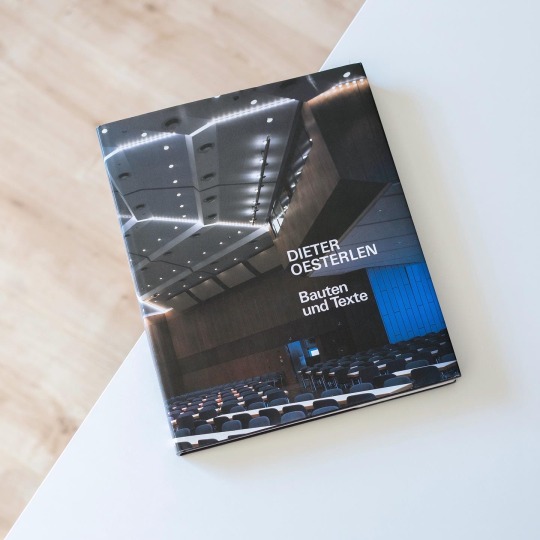
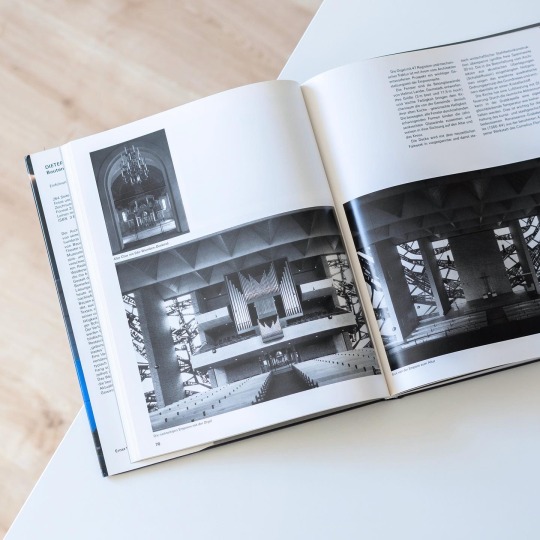
It is rather surprising that the name of Dieter Oesterlen (1911-94) has largely faded into obscurity: as one of three figureheads of the so-called „Braunschweiger Schule“ Oesterlen trained countless students at the Technical University in Braunschweig and also significantly contributed to German postwar architecture. During the course of his career he developed two major typological strands, namely church architecture and the construction in existing contexts, most prominently represented by the Christuskirche in Bochum and the Landtag of Lower Saxony in Hannover, the city where Oesterlen also spent most of his life.
Although in recent years a critical monograph on the architect by Anne Schmedding has been published the present volume still offers the most comprehensive visual source to his work: „Dieter Oesterlen - Bauten und Text 1946-1991“, published in 1992 by Wasmuth Verlag, is a personal compilation of 36 buildings and 19 texts by Oesterlen himself, generously illustrated with plans and photos, many of them taken by Heinrich Heidersberger. They demonstrate not only Oesterlen’s development from a restrained postwar modernist towards a Brutalist architect but also show his dealing with reconstruction: especially in the case of the Marktkirche in Hannover Oesterlen sought to purify the interior by exposing the brick walls and vaults and intentionally juxtaposing the old and the new.
In the back of the book the architect’s texts and lectures provide interesting insights into Oesterlen’s long-term teaching at TU Braunschweig as well as his conception of architecture. From these texts, lectures and speeches Oesterlen’s increasing alienation from contemporaneous concepts of space and architecture becomes clear, probably one of the reasons why he fell into obscurity in the late 1970s.
Due to the direct involvement of Oesterlen the book of course is highly subjective and e.g. spares out his work during the Third Reich but is otherwise indispensable for a full appreciation of his oeuvre and a handy argumentation aid for discussing the protection of his buildings.
#dieter oesterlen#monograph#architecture#germany#nachkriegsarchitektur#nachkriegsmoderne#architecture book#book#vintage book
24 notes
·
View notes
Text
By the mid-1960s, Godard was in Paris making some of the early masterpieces of the French New Wave, but the earlier wondrous optimism he’d felt for concrete was now replaced by a horrified fascination. The modernist utopian dream that the speed and malleability of concrete might solve housing crises, revolutionize cities and birth new ways of living and being was already being shattered by a spiraling capitalist cycle of speculation, construction, deterioration and demolition.
In “Alphaville” (1965), a tyrannical dystopia, Godard used the newly concreted areas of Paris as a backdrop. Two years later, in the opening scene of “Deux ou trois choses que je sais d’elle,” a wheelbarrow caked in concrete sat on a recently built motorway, surrounded by a deafening cacophony of traffic and construction. Everywhere the camera looked, Paris was full of holes and craters; cranes filled the sky and the new concrete tower blocks were portrayed as monuments of alienation and loneliness. Godard theorized that the city, like his female protagonist, had been forced to prostitute itself just to survive in an era of “progress.”
27 notes
·
View notes